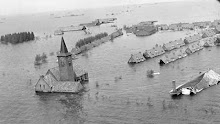Life list now 200 species
>>More on Salt Pans
After this successful introduction to the Salt Pans, I tried to fit in one visit per week and my next five visits were on the following dates: Sun 22 Mar, Sun 31 Mar, Sun 7 Apr, Sat 13 Apr and Thurs 18 Apr 1946. Many of the same birds were present each time so, to avoid repetition, I am including here only new observations. >>>
On 22 March these consisted of behaviour details of one species and occurrence of two new wader species. The behaviour description: “I saw four single _____________________. Each of these gave me good views. The best was one I flushed from the bank and it perched on a low post about 12" above water level) some 5 yds from the bank and 30 yds from me. Several times it uttered what I find to be its characteristic alarm note, an explosive ‘sneeze’ - ‘ptzuuk’ or, on occasion, a more metallic ‘tzink’. All the while it jerked its short tail at a frequency of approx twice per sec. Its pose was rather peculiar - almost horizontal, or about as sketched, and became quite horizontal preparatory to taking wing.”
QUIZ: If you think you know what species this bird was, please put its name, your name, how you identified it and the date (22 March 1946) in the comment box at the end of this post.
Two additions to my species list for Aden, one a lifer: “At another point I was attracted by the sight of a white head, black crowned, just visible above the bank. It turned out to belong to one of six Avocets* Recurvirostra avosetta. These flew up when I was 50-70 yds away showing their upturned bills and characteristic wing pattern very clearly. They landed in the centre of the pool, swimming quite freely and lightly on the water. Then, nearby, were three Black-winged Stilts Himantopus himantopus. They showed all their characteristic features [as observed by me on Nottingham sewage farm the previous year] but did not call. There was some black on the head, little on crown, mostly through the eye (?)”
The visit on 31 March turned up three more wader species for the Salt Pans, two of them lifers.
“With c 12 Little Stints on the bank was one _____________________*. I took down the following description on the spot: Bill longish, up-curved, black or very dark with slight yellowish at base. Dark line thro’ eye. Legs short and yellowish. Back and wings ashy-brown, almost uniform. Shoulders, upper neck and crown lighter and more streaked. Face, forehead, throat and upper breast white with greyish or grey-brown speckles. Rest of underparts, white. Little white in tail but secondaries and, probably primaries, white tipped giving a white trailing edge to the wing. Call ‘twit-a-wit-wit-wit’.
QUIZ: If you think you know what species this bird was, please put its name, your name, how you identified it and the date (31 March 1946) in the comment box at the end of this post.
On the mud of another pool were 10 Flamingos, 2 Greenshanks, several Little Stints and 9 _____________________________*. Following description taken at the time: Size, just greater than that of Little Stint (one with them). General colour of upperparts grey-brown, but rather varied among individuals, some browner than others. Head, streaked much as with a snipe but greyer and lighter. Bill, fairly long and heavy, down curved but not as much as in Curlew Sandpiper - almost black in colour. Whitish eye-stripe noticeable. Underparts chiefly white, some colour on breast. Note, a very short titter.
QUIZ: If you think you know what species this bird was, please put its name, your name, how you identified it and the date (31 March 1946) in the comment box at the end of this post.
In this pool, among the Little Stints, I heard the call of the Dunlin Erolia alpina but did not see it, though I saw one Dunlin (only a spot or two of black on the belly) on another part of the salt pans the same day."
7 April 1946 was notable for the addition of four more species of wader to my Aden list, though none of them were lifers. They were Lesser Sandplover Charadrius mongolus (as seen in Egypt), Grey Plover Squatarola squatarola, Whimbrel Numenius phaeopus and Bar-tailed Godwit Limosa lapponica.
On 13 April, I discovered my first breeding evidence on the salt pans, from “2+ pairs of Kentish Plovers. I suspect from their curious behaviour that they were breeding. They seemed anxious to lead me from a particular area. One representative of each pair (♀?) was the most perturbed. The method of each bird was to land about 20 yds from me and run away from me, adopting a crouching posture with wings slightly open, fluttering and pressed downwards. The tail was considerably depressed and spread, showing the white sides of tail and rump very prominently.”
The following week, 18 April, in the same area, more breeding evidence was obtained. I saw “five Kentish Plovers, one of which was a juvenile. It was the same size as the others but upper parts were much less uniform, being spotted and streaked with white (?). Black on head and neck missing. The forehead was nearly white but not sharply divided by a black line from the dark crown.”
Two of the waders named above were further additions to the Aden avifauna, bringing the number of species I had added so far to four. The new species for Aden were Avocet and Broad-billed Sandpiper, which do not figure in the lists preceding my visit. However, other observers after me reported them (e.g. Page 1960).
Subscribe to:
Post Comments (Atom)



No comments:
Post a Comment